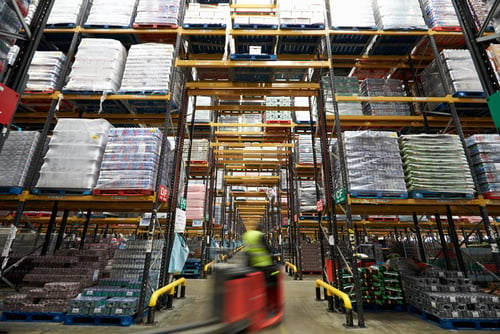August 26, 2025
How Bulk Storage Solutions Drive Better Warehouse Space Optimization
Written by: The Materialogic Team

When warehouse space becomes tight, every square foot counts. Inefficient storage can slow operations, increase costs, and limit your ability to scale. The good news? With the right strategies, you can maximize storage capacity without sacrificing workflow efficiency. Whether you’re managing growing inventory levels or looking to optimize existing layouts, small adjustments can make a big impact on space utilization.
One of the most effective methods of warehouse space optimization is to reassess how and where inventory is stored. From identifying underused space to implementing bulk storage solutions, this guide will walk you through the best ways to free up room and ensure your warehouse can support your business’s long-term growth.
Identify Underused Warehouse Space
A key element of warehouse space optimization is modifying your rack and pallets space. Slow-moving materials, unprocessed inventory, or products that can’t be placed can often lead to inefficiencies. Taking care of this material is an easy way to increase storage capacity, but you should also consider taking an analytical look at the layout of your entire warehouse to streamline operations.
Smart warehouse space optimization includes analyzing the way your space is used. This can be completed in four steps:
1. Calculate your total storage area
This can be done by measuring the total square footage of your warehouse and multiplying it by the warehouse’s clear height. Be sure to avoid counting the spaces that aren’t used for storage purposes (offices, lunchrooms, etc.) and remove that footage from the final number.
2. Calculate maximum storage capacity based on the current layout
Multiply the length and width of your racks’ external dimensions (the storage area footprint). If you’re using shelves, calculate the internal volume of shelves. Then, multiply that number by the height of the highest load in that area.
3. Determine potential storage area
To calculate this, divide your maximum storage capacity by the total warehouse storage area and multiply it by 100. The ideal result should be around 22–27% because this indicates your warehouse still has enough room for your workers to move around efficiently. If your result is below 22%, this can indicate that you have wasted warehouse space. A result higher than 27% can indicate that your personnel doesn’t have enough room to work, leading to lower labor productivity.
4. Calculate storage space utilization using WMS
A warehouse management software (WMS) is vitally important to keep your inventory organized and up to date. In this case, it can help you gather all the data you need to better optimize your workspace. Simply add the volume of your inventory and divide the total by the maximum storage capacity and multiply by 100. You can compare this number with the results of your efforts to optimize the warehouse storage process.
If you have completed these steps and are still finding that your storage space doesn’t have the right room, it may be time to build up instead.
Evaluate Your Racks
Ensuring you are using the right racks for your warehouse may seem like a no-brainer, but as your warehouse space gets more and more cluttered with little space for product, it can lead to simple fixes being overlooked. There are several different types of racks used in common warehouse setups:
Pallet racks
Pallet racks are essential storage racks. You likely have several of these set up already. These basic racks, combined with forklifts and pallets, are efficient ways of maximizing your storage space if you have a variety of inventory.
Carton flow racks
Carton flow racks have slanted panels that push down older inventory so it is more easily accessible. These racks are ideal for first-in, first-out inventory processes.
Cantilever racks
Cantilever racks have protruding arms where inventory can be placed. These racks are good for storing long inventory such as piping, lumber, or steel.
Mezzanines
Mezzanines are platforms that extend storage space to a second level above your warehouse floor.
Adding more racks to your storage space can also have some pitfalls. For example, before expanding, take the time to be aware of your building’s fire code and ensure that you aren’t breaking any coding rules by extending racks. Additionally, consider that your employees may need extra equipment to reach higher levels of inventory and incorporate that into your warehouse space optimization strategy.
Can’t Fit? Consider Bulk Storage Solutions
Bulk storage solutions may be the answer if your space constraints don’t align with your inventory purchases. When you make large purchases of inventory, you are creating opportunities to manage it with tailored bulk storage solutions. Bulk storage containers can reduce the number of physical storage bins, and may not even need to be located in your warehouse. Example containers include:
- Vats
- Silos
- Tanks
- Drums
- Super sacks
- Industrial storage bins
- Bulk containers
Ideally, these bulk storage containers will be stored at another warehouse that allows you to rent only the space you need to manage your inventory overflow. On-demand warehousing offers the agility and flexibility you may not get inside your limited warehouse space.
Stay Organized With the Right 3PL
Insight into your inventory starts with robust and accurate warehouse management software. Materialogic’s cloud-based technology updates your inventory in real time and supports long-term fulfillment. Our team of experts provides this, along with customized services ranging from bulk storage solutions to eCommerce order fulfillment, to give your operation exactly the tools it needs to succeed.
Download our brief guide for more insight into warehouse space optimization or schedule a quick discovery call with our team to see whether bulk storage solutions are a good fit for your operation.
